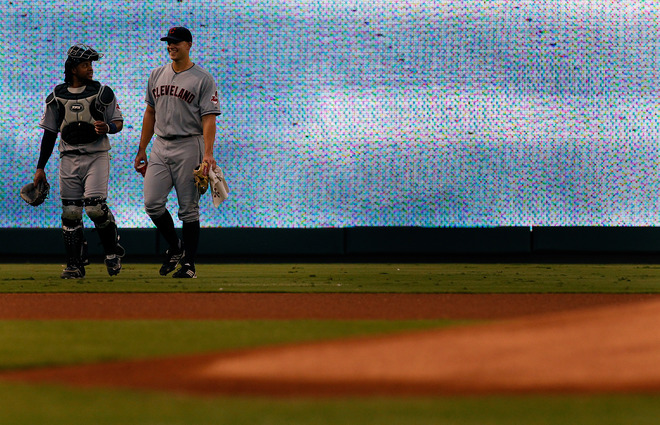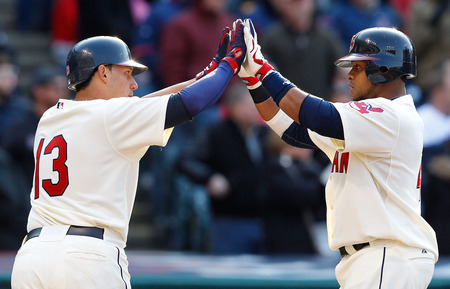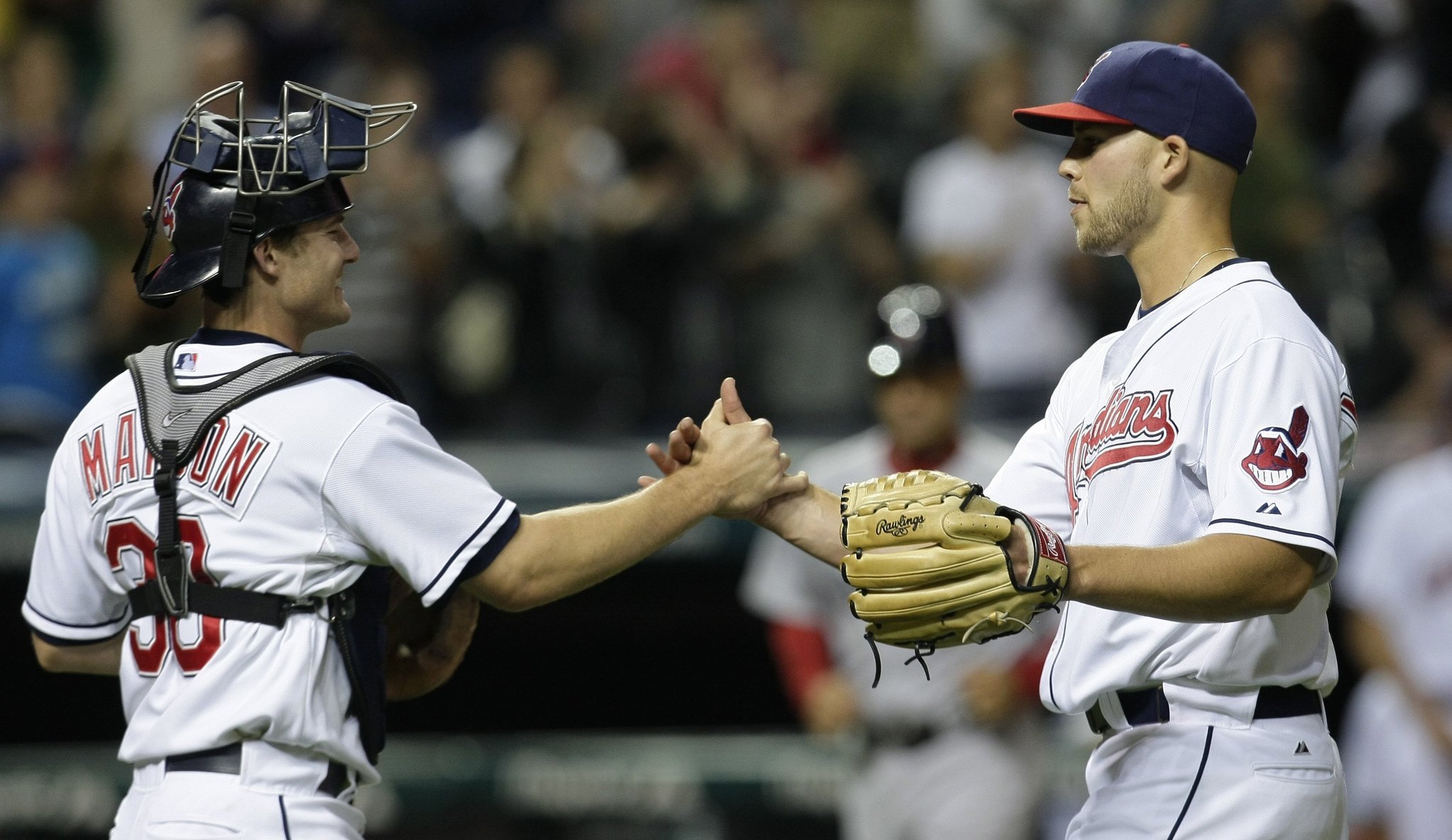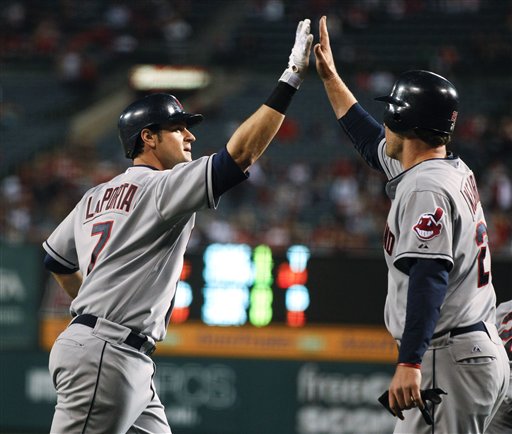 Indians Archive
Indians Archive  Core Building Exercises
Core Building Exercises

With the Indians still sitting in 1st place, winning games that they have no business winning (Monday) or somehow remaining in games that look like lost causes until the final at-bat (Tuesday), the opinions on whether the Indians’ success is sustainable has been the hottest topic to hit the North Coast since a certain athlete sat in a Boys and Girls Club in Connecticut. While the current vibe is unquestionably positive about the Tribe – regardless of what the future months may hold – it is stunning to look at the makeup of this team, off to such a hot start and to remember from whence they came.
Since every national (and local) publication that piled on the Indians for their off-season, questioning the intentions ownership and the competency of the Front Office, has had to begrudgingly acknowledge that the Indians have some pieces and parts that could keep them in contention, let’s all remember that it has now been just over a season-and-a-half since those horrible couple of days in late July of 2009, when Victor sat crying in front of his locker, consoling his son while CP Lee could hardly contain his glee in TV interviews about being with a contender in Philadelphia as the hope that the success from 2007 would lead to something flitted away.
That was 21 months ago and in those months, the Indians hit rock bottom (seemingly digging for new bottoms a couple of times along the way), scraped along the bottom for about a year until about the All-Star Break last year, then began to swim slowly and largely unnoticed upwards. With the performance of the first couple weeks of the season, there is a sense that the Indians’ struggle against the current has not been in vain and the early hot streak has the look of a salmon, leaping from the water in the midst of swim upstream – with a kind of a “remember us?” feel to it.
With this hot start though, it’s fair to ask how the Indians got here, and to that end my TCF colleague Andrew Clayman has penned an interesting piece regarding the manner in which the current Indians were built, comparing them to their partners in the penthouse (for now) of the AL Central, the KC Royals. The whole piece is worth your time as it is extremely well-researched as Clayman attempts to quantify how the current Indians came to be, going much further than simply rehashing the draft failures of the better part of a decade that are already well-known. His takeaway thought on the manner in which the Indians have been built is a particularly interesting one as he asks, “did Shapiro and Co. manage to clean up the mess of their draft failures by trading away the old core for a new one?”
Just to carry that thought further, did they really do it this quickly?
With a lineup, rotation, and bullpen full of players that made their way into the organization in a manner OTHER than the draft, is it possible that “The Plan” (v2.0) to add similarly-aged, similarly-controlled players into the organization has already started to come to fruition, just two-and-a-half-seasons after the decision to trade CC and, to a lesser degree, Casey Blake?
While so much focus is placed on the trades of CC, Clifton Phifer, and El Capitan (and I’ll get to that) in terms of the Indians adding potential building blocks, since Blake’s name has been evoked, it is worth noting that the Indians’ current #2 through #4 hitters came about in trades for Eduardo Perez, Ben Broussard, and Lacey Cake.
Read that again and add Einar Diaz and Ryan Drese on the list if you want to include the Tribe’s #5 hitter and how he found his way to the North Coast. For all of the high-profile trades that the Indians have been involved in, they made silk out of sows’ ears in each of those trades, and the middle-of-the-order is a daily reminder of that.
Just to expand on how impressive that is, Eduardo Perez had all of 102 plate appearances for the Mariners (.545 OPS in those PA) before retiring after that 2006 season while Ben Broussard strode to the plate only 530 more times (.695 OPS in those PA) after being traded by the Indians that same season. The Indians have their #2 and #3 hitters to show for those two trades in July of 2006. Going further, Casey Blake has been the most successful of the trio that was moved for the Indians’ middle-of-the-order as he’s posted a .779 OPS over the last 4 seasons in LA, but the Indians traded him when he was 34 years old and they netted one of the best young hitting prospects in baseball (2011 numbers considered) from a premium defensive position.
However, for as many accolades as the Indians have received for netting The Axe Man for a 34-year-old infielder, everyone realizes that Mark DeRosa has played in a total of 102 games (posting a cumulative .669 OPS in 381 plate appearances in 2+ years) since being traded by the Indians in the middle of 2008, right?
Meanwhile, the main player acquired for DeRosa (the other is Jess Todd) has become enough of a force on the local landscape that T-shirts are being printed with his likeness (and how could you not order one of these) with all of the attention certainly well-deserved. If you think that C. Perez – he of the wild hair, the braggadocios Twitter account, and the direct path from the mound towards home after every pitch – is just “sound and fury, signifying nothing”, realize that since the beginning of last season, Pure Rage has a 1.54 ERA, a 1.02 WHIP and has struck out nearly a batter an inning en route to 29 saves. Chris F. Perez hasn’t allowed an earned run since August 6th of last year, when he allowed 2 earned runs. Those 2 earned runs are the only ones that he’s allowed since the end of June last year.
Let me re-state that in different terms so it isn’t lost on anyone – in his last 41 1/3 IP over his last 40 games, Chris Perez has allowed 2 earned runs. That’s a 0.43 ERA for a 25-year-old that the Indians control THROUGH the 2014 season…all for ½ of a season of Mark DeRosa.
While you may not have realized what those players (E. Perez, Broussard, Blake, DeRosa) did after leaving Cleveland, the knowledge that the Indians committed some grand larceny in those deals is pretty well-known. Without delving into the fact that Kelly Shoppach has played in all of 75 games since being traded to the Rays (with 6 HR and a .641 OPS since the trade from Cleveland) or any of the other trades that have netted the Indians a roster full of other teams’ prospects that are winning, suffice it to say that the Tribe has found success identifying when a player is close to the end of his usefulness, and flipping said player for a young player with some potential.
But seeing as how we all know that the Indians were proficient in these deals, realize that those trades may have brought a middle of the order to the North Coast while settling the back end of the bullpen, the trades of CC, Lee, and Victor are the ones that have received the most attention. On those deals, Chris Antonetti had this to say to ESPN’s Jayson Stark, “if you look back at the deals we made in 2008 and 2009, we made them because we weren’t competitive. If we had been the team we wanted to be in 2008, we wouldn’t have traded CC [Sabathia].”
As much as people wail and gnash over those trades, the Indians made those moves because they weren’t winning enough to justify keeping those guys around, particularly CC in 2008. While the trades of Lee and Victor were/are much maligned locally, the current 1st place Indians boast 40% of their rotation from those moves, with more players likely to arrive in Cleveland – be it in the coming months or coming years.
 If you’ll remember, the major complaint about those moves is that the Tribe didn’t receive MLB-ready starters that could fit in the top of their rotation. Remember all of the howling that the Indians didn’t extract Clay Buchholz from New England for either CP Lee or Victor?
If you’ll remember, the major complaint about those moves is that the Tribe didn’t receive MLB-ready starters that could fit in the top of their rotation. Remember all of the howling that the Indians didn’t extract Clay Buchholz from New England for either CP Lee or Victor?
Here is how two former Red Sox farmhands have performed since the beginning of August of last year up to, but not including, Wednesday’s game:
Justin Masterson
2.45 ERA, 1.14 WHIP, 7.1 K/9, 2.29 K/BB in 77 IP
Clay Buchholz
2.97 ERA, 1.38 WHIP, 7.2 K/9, 1.57 K/BB in 75 2/3 IP
Certainly, the 2010 numbers that Buchholz put up put Masterson’s season last year to shame, but if Masterson turned this imaginary corner in the second half of last year, these numbers – particularly sustained over 75+ innings – are hard to ignore. Figure that Buchholz is actually 7 months older than Masterson and one can’t help but get even more excited about Justin Credible.
But Masterson was just one component of the Victor deal as LHP Nick Hagadone now has 10 K in 8 2/3 scoreless innings while hitting the mid-90s on the gun in AA Akron and it may not be too long before he ascends to the parent club to take a place in the bullpen, perhaps providing ANOTHER power arm for the back-end, which is suddenly quite full of them. The third player netted from Boston (Bryan Price) has struggled in the early going this year, but could join Hagadone in the Indians’ bullpen if he gets on track, again perhaps even this year.
Those are just bullpen arms though – fungible commodities that can be found late in the draft, as Tony Sipp and Vinnie Pestano were – the real value that needs to be found is in the starting rotation, right?
That’s where we get back to these trades as we get to the most derided trade that was consummated by the Tribe, as Lee was dealt for a quartet of Phillies’ Minor Leaguers, one of whom just happens to be sitting in the Indians’ rotation, just a season-and-a-half after the trade, in Carlos Carrasco. While CarCar has been inconsistent in the early going this year and remains a largely unknown commodity, realize that there are 20 pitchers in MLB that are 24 or younger that have thrown more than 15 innings this year and Carrasco’s 4.85 ERA puts him 13th among that group, just below most people’s AL Rookie of the Year pick, Tampa Bay’s Jeremy Hellickson.
Certainly CarCar has endured his fair share of deplorable innings, but he’s shown the repertoire that you’d like to see out of a 24-year-old RH starter as over his last 3 starts, he’s posted a 3.26 ERA and a 1.13 WHIP while striking out 15 and walking just 6 in the 19 1/3 innings in those 3 starts. He’s also given up only 1 HR in his first 26 innings pitched on the year after giving up 16 HR in 25 starts in Columbus last year. While he’s far from a finished product, he is still just 24 years old and with Marson filling a role for the Tribe (and quite adequately) and with Jason Donald not far away from likely returning to the Indians, the Lee deal will likely have netted 3 players on the 25-man roster less than 2 years after the trade was completed, with the possibility of Hagadone joining the club this year making it plausible that 5 players on the 25-man roster (20% of a young and promising ballclub) came over in the Victor and Lee deals.
Of course, Jason Knapp remains the great wild card in the Lee deal, but if you’re looking for the quick return from the Clifton Phifer trade, you need only to look to the pitching rubber every 5th day to see what could be, in Carrasco, a top-to-middle-of-the-rotation starter emerging as the months pass.
As for the final big trade from the past few years that received much derision heading into the season, how about the fact that LaPorta’s OPS for the year is now sitting at .827, with a 140 OPS+, two cumulative numbers that put him 3rd on the team among regulars in both categories. Now, does the guy look like Pedro Cerrano on certain pitches, flailing away or (even worse) like Willie Mays Hayes on others, with the ol’ “excuse me” grounders that inch through the infield?
You’d have to be blind not to see those discouraging signs from LaPorta, but over his last 12 games, MaTola has a .957 OPS and his batting eye has been more in line with what he put forth in MiLB. While on the farm, his OBP – .386 OBP in AA, .400 OBP in AAA – was one the most attractive things about LaPorta, and that discerning batting eye finally seems to be translating to MLB.
 After posting modest BB% numbers his first two years in Cleveland, LaPorta has walked in 13.3% of his plate appearances, highest among Tribe regulars and 18th highest in all of MLB. Given LaPorta’s OBP in MiLB and his ability to draw a walk in 2011, perhaps the expectations for LaPorta need to be adjusted to realize that this guy may be content to sit and wait for his pitch, in the hopes that he can drive it. Perhaps he is only able to drive mistake fastballs as his line drive percentage is atrocious (12.2% - 80th of the 95 qualified MLB hitters), which explains how LaPorta either drives the ball with authority or simply squibs the ball around the diamond. Maybe he’s a mistake-ball hitter, which allowed him to post giant AAA numbers and why he’s able to make an impact from time to time in MLB.
After posting modest BB% numbers his first two years in Cleveland, LaPorta has walked in 13.3% of his plate appearances, highest among Tribe regulars and 18th highest in all of MLB. Given LaPorta’s OBP in MiLB and his ability to draw a walk in 2011, perhaps the expectations for LaPorta need to be adjusted to realize that this guy may be content to sit and wait for his pitch, in the hopes that he can drive it. Perhaps he is only able to drive mistake fastballs as his line drive percentage is atrocious (12.2% - 80th of the 95 qualified MLB hitters), which explains how LaPorta either drives the ball with authority or simply squibs the ball around the diamond. Maybe he’s a mistake-ball hitter, which allowed him to post giant AAA numbers and why he’s able to make an impact from time to time in MLB.
As nice as it would be to be able to see LaPorta as the RH power bat that we all envisioned back in July of 2008, there’s a good possibility that MaTola is merely Pete O’Brien or Paul Sorrento – a solid, if unspectacular, bat. Maybe he evolves into more, but even if we’re talking about that “solid, if unspectacular, bat” some context is in order in terms of listing the cavalcade of 1B since Thome left after the 2002 season with Ben Broussard, Ryan Garko, Victor Martinez, and Casey Blake being the most notable names.
However, over the course of nearly a decade that quintet spent time at 1B along with the likes of Shane Spencer, Lou Merloni, Josh Phelps Jose Hernandez, Eduardo Perez, Chris Gomez, Mike Aubrey, Andy Gonzalez, Chris Gimenez, Andy Marte, Niuman Romero, Jordan Brown, and of course, Rusty Branyan.
Hell, there was somebody named Jeff Liefer who started 4 games at 1B for the 2005 Indians!
But in 9 years, they’ve had THAT many players man 1B and even if Matt MaTola is Pete O’Brien or Paul Sorrento, he has the ability to be a contributor on a winning team. Maybe LaPorta doesn’t ever provide the level of contribution that we would have expected – or hoped for – when he was the centerpiece of the CC deal, but a solid contributor (under club control through 2015) provides some stability to a position that’s been badly in need of it.
Even if MaTola “only” ends up being that solid bat at 1B, the second player netted for CC has made strides enough this year that it’s not difficult to see Mike Brantley as the PTBNL who provides the needed justification for the deal with the Brewers. Right now, Brantley’s .400 OBP ranks him 14th in the AL in that category and while you can certainly point to his .370 BABIP, 10th highest in the AL, as evidence that his success may be unsustainable. However, Brantley’s BABIP in 2009 in Cleveland was .376 and his BABIP in AAA last year was .342, so it’s possible that Brantley is one of those odd instances of a player who is able to generate more hits when he puts the ball in play than others.
While it is unlikely that Brantley ever turns into much of a power threat (his OBP is higher than his SLG this year), if the game is shifting from a game of power to a game of speed, slotting Brantley into the lineup (wherever, I don’t really care) and into the OF for the next five years or so means that the Indians could have the stability that they haven’t had in LF for quite some time…I don’t think you need me to list the players that have plied their craft in LF over the last decade.
Regardless of whether the early-season success of the Tribe is sustainable, the contributions from players – young, promising, highly-regarded prospects – acquired via trades have unquestionably provided some much-needed hope for a franchise that had become derided for everything that they had been unable to do. Now perhaps we’re seeing what they HAVE been able to do, as they’ve filled roles up and down the roster via trade with the answer to Clayman’s question as to whether “Shapiro and Co. managed to clean up the mess of their draft failures by trading away the old core for a new one” starting to find some answers. Certainly, the hit rate has not been 100% (Yohan Pino, the arm acquired for Carl Pavano was just sold to the Blue Jays) on moving veterans for youngsters over the past two-and-a-half years, but with the performance of a young team early in this season (and with Victor Martinez hitting the DL in Detroit serving as a reminder of the “luck” that has befallen the Indians since 2008), one can’t help but notice that the pieces that are supposed to serve as the cornerstones for the next incarnation of the Indians are starting to emerge.
After watching the earth scorched for the better part of two-and-a-half seasons, with Indians fans watching the barren ground, waiting for something to emerge, the performance of the Indians in the early going has provided the hope that the seeds sewn have not only taken root, but that they’ve broken through and are on their way up.
How much the team continues to grow over the course of the year remains to be seen, but after the last few seasons feeling like an extended winter, in terms of hopelessness and bitter cold, it is nice to finally feel the warmth of winning while a garden grows again in Cleveland.
- NBA Announces 2013-2014 Schedule
- Browns Ink Sharknado
- Sharknado A No-Show For Rookie Camp
- Trent Richardson Out Until Training Camp
- Browns Sign Brandon Jackson
- Carrasco Suspended Eight Games
- Browns Add to Wide Receiver Depth with David Nelson
- Browns Need to Learn from Past Draft Mistakes
- Browns Release Chris Gocong and Usama Young
- Browns Missing on Grimes Disappointing, But Not The End
The TCF Forums
- Chris Grant's first 3 drafts
Kingpin74 (Tuesday, January 21 2014 10:13 AM) - The 2014 Offseason Thread
googleeph2 (Tuesday, January 21 2014 9:36 AM) - 2015 Recruiting
furls (Tuesday, January 21 2014 6:57 AM) - Mike Brown
YahooFanChicago (Monday, January 20 2014 11:15 PM) - Movies coming out
HoodooMan (Monday, January 20 2014 9:34 PM) - 2014 Hoops Hockey Hijinx
jpd1224 (Monday, January 20 2014 4:44 PM) - 2014 Recruiting
jclvd_23 (Monday, January 20 2014 2:26 PM) - Wish List - #4 Pick
Hikohadon (Monday, January 20 2014 1:26 PM) - Official- Browns Coach Search/Rumors
OldDawg (Sunday, January 19 2014 6:48 PM) - #1 overall pick Anthony Bennett
TouchEmAllTime (Sunday, January 19 2014 1:28 PM)


